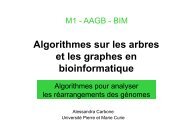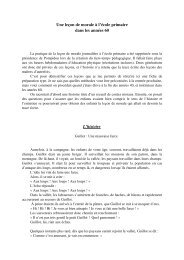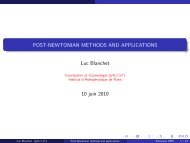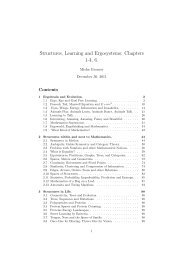The zero locus of the infinitesimal invariant - Institut des Hautes ...
The zero locus of the infinitesimal invariant - Institut des Hautes ...
The zero locus of the infinitesimal invariant - Institut des Hautes ...
Create successful ePaper yourself
Turn your PDF publications into a flip-book with our unique Google optimized e-Paper software.
THE ZERO LOCUS OF THE INFINITESIMAL INVARIANT 5To prove <strong>The</strong>orem 1.1, it is clearly sufficient to show that <strong>the</strong> set Ĩ(ν) is constructiblein <strong>the</strong> Zariski topology on T X. Lemma 4.4 and Lemma 4.5 reduce <strong>the</strong>problem to <strong>the</strong> following general result in abstract algebraic geometry: On any algebraicvariety, <strong>the</strong> <strong>zero</strong> <strong>locus</strong> <strong>of</strong> a section <strong>of</strong> a coherent sheaf is constructible (butnot, in general, Zariski closed). This fact is certainly well-known, but since it wassurprising to us at first, we have decided to include a simple pro<strong>of</strong> in <strong>the</strong> followingsection.5. Zero loci <strong>of</strong> sections <strong>of</strong> coherent sheaves. In this section, we carefullydefine <strong>the</strong> “<strong>zero</strong> <strong>locus</strong>” for sections <strong>of</strong> coherent sheaves, and show that it is alwaysconstructible in <strong>the</strong> Zariski topology. This is obviously a local problem, and so itsuffices to consider <strong>the</strong> case <strong>of</strong> affine varieties. Let R be a commutative ring withunit; to avoid technical complications, we shall also assume that R is Noe<strong>the</strong>rian.For any prime ideal p ⊆ R, we denote by <strong>the</strong> symbolκ(p) = R p /pR p<strong>the</strong> residue field at p; it is isomorphic to <strong>the</strong> field <strong>of</strong> fractions <strong>of</strong> <strong>the</strong> local ring R p .Let X = Spec R be <strong>the</strong> set <strong>of</strong> prime ideals <strong>of</strong> <strong>the</strong> ring R, endowed with <strong>the</strong> Zariskitopology. For any ideal I ⊆ R, <strong>the</strong> setV (I) = { p ∈ X ∣ ∣ p ⊇ I}is closed in <strong>the</strong> Zariski topology on X, and any closed subset is <strong>of</strong> this form; likewise,for any element f ∈ R, <strong>the</strong> setD(f) = { p ∈ X ∣ ∣ p ∌ f}is an open subset, and <strong>the</strong>se open sets form a basis for <strong>the</strong> Zariski topology.Definition 5.1. A subset <strong>of</strong> X is called constructible if it is a finite union <strong>of</strong> subsets<strong>of</strong> <strong>the</strong> form D(f) ∩ V (I).Here is how this algebraic definition is related to constructibility on complexalgebraic varieties. Suppose that R is a C-algebra <strong>of</strong> finite type. Let X(C) be <strong>the</strong>set <strong>of</strong> all maximal ideals <strong>of</strong> R, endowed with <strong>the</strong> classical topology; it is an affinecomplex algebraic variety, and <strong>the</strong> inclusion mapping X(C) ↩→ X is continuous.Definition 5.2. A subset <strong>of</strong> X(C) is called constructible (in <strong>the</strong> Zariski topology)if it is <strong>the</strong> set <strong>of</strong> maximal ideals in a constructible subset <strong>of</strong> X.Any coherent sheaf on X = Spec R is uniquely determined by <strong>the</strong> finitely generatedR-module <strong>of</strong> its global sections; conversely, any finitely generated R-moduleM defines a coherent sheaf on X, and hence by restriction to <strong>the</strong> subset X(C) analgebraic coherent sheaf F M on X(C). Its fiber at <strong>the</strong> point corresponding to amaximal ideal m ⊆ R is <strong>the</strong> finite-dimensional C-vector spaceM ⊗ R κ(m) = M m /mM m .Similarly, any element m ∈ M defines an algebraic global section s m <strong>of</strong> <strong>the</strong> sheafF M . Obviously, s m vanishes at <strong>the</strong> point corresponding to a maximal ideal m ⊆ Rif and only if m goes to <strong>zero</strong> in M ⊗ R κ(m). Thus if we defineZ(M, m) = { p ∈ X ∣ ∣ m goes to <strong>zero</strong> in M ⊗ R κ(p) } ,<strong>the</strong>n <strong>the</strong> <strong>zero</strong> <strong>locus</strong> <strong>of</strong> s m on X(C) is precisely <strong>the</strong> set <strong>of</strong> maximal ideals in Z(M, m).Thus <strong>the</strong> <strong>des</strong>ired result about <strong>zero</strong> loci <strong>of</strong> sections <strong>of</strong> coherent sheaves is a consequence<strong>of</strong> <strong>the</strong> following general <strong>the</strong>orem in commutative algebra.
6 G. PEARLSTEIN AND CH. SCHNELLProposition 5.3. Let R be a commutative Noe<strong>the</strong>rian ring with unit. <strong>The</strong>n for anyfinitely generated R-module M, and any m ∈ M, <strong>the</strong> set Z(M, m) is constructible.Pro<strong>of</strong>. We are going to construct a finite coveringn⋃Spec R = D(f k ) ∩ V (I k )k=1with f 1 , . . . , f n ∈ R and I 1 , . . . , I n ⊆ R, such that for every k = 1, . . . , n, one hasZ(M, m) ∩ D(f k ) ∩ V (I k ) = D(f k ) ∩ V (I k + J k ),for a certain ideal J k ⊆ R. This is sufficient, because it implies thatn⋃Z(M, m) = D(f k ) ∩ V (I k + J k )k=1is a constructible subset <strong>of</strong> Spec R.Since M is finitely generated and R is Noe<strong>the</strong>rian, we may find a presentation(5.4) R ⊕q A−→ R ⊕p → M,in which A is a p × q-matrix with entries in R. Let y ∈ R ⊕p be any vector mappingto m ∈ M. <strong>The</strong>n Z(M, m) is <strong>the</strong> set <strong>of</strong> p ∈ Spec R such that <strong>the</strong> equation y = Axhas a solution over <strong>the</strong> field κ(p).We construct <strong>the</strong> <strong>des</strong>ired covering <strong>of</strong> Spec R by looking at all possible minors<strong>of</strong> <strong>the</strong> matrix A. Fix an integer 0 ≤ l ≤ min(p, q) and an l × l-submatrix <strong>of</strong> A;to simplify <strong>the</strong> notation, let us assume that it is <strong>the</strong> l × l-submatrix in <strong>the</strong> upperleft corner <strong>of</strong> A. Let f be <strong>the</strong> determinant <strong>of</strong> <strong>the</strong> submatrix, and let I be <strong>the</strong> idealgenerated by all minors <strong>of</strong> A <strong>of</strong> size (l + 1) × (l + 1); if l = 0, we set f = 1, andif l = min(p, q), we set I = 0. We can <strong>the</strong>n make a coordinate change in R ⊕q ,invertible over <strong>the</strong> localization R f = R[f −1 ], and arrange that⎛⎞f 0 · · · 0 0 · · · 00 f · · · 0 0 · · · 0. .. ..A =0 0 · · · f 0 · · · 0∈ Mat p×q (R).a l+1,1 a l+1,2 · · · a l+1,l a l+1,l+1 · · · a l+1,q⎜⎟⎝ . .. .. ⎠a p,1 a p,2 · · · a p,l a p,l+1 · · · a p,qNow let J ⊆ R be <strong>the</strong> ideal generated by <strong>the</strong> elementsfor i = l + 1, . . . , p. <strong>The</strong>n we havefy i −l∑a i,j y jj=1Z(M, m) ∩ D(f) ∩ V (I) = D(f) ∩ V (I + J).Indeed, suppose that p is any prime ideal with f ∉ p and I ⊆ p. Since a i,j ∈ p forevery l + 1 ≤ i ≤ p and l + 1 ≤ j ≤ q, <strong>the</strong> equation y = Ax reduces over <strong>the</strong> field
THE ZERO LOCUS OF THE INFINITESIMAL INVARIANT 7κ(p) to <strong>the</strong> equations y i = fx i for i = 1, . . . , l, andy i =l∑a i,j x jj=1for i = l + 1, . . . , p; <strong>the</strong>y are obviously satisfied if and only if J ⊆ p.We now obtain <strong>the</strong> assertion by applying <strong>the</strong> above construction <strong>of</strong> f, I, and Jto all possible l × l-submatrices <strong>of</strong> A.□Here is a simple example to show that, when <strong>the</strong> coherent sheaf is not locallyfree, <strong>the</strong> <strong>zero</strong> <strong>locus</strong> <strong>of</strong> a section need not be Zariski closed.Example 5.5. Let R = C[x, y], let M be <strong>the</strong> ideal <strong>of</strong> R generated by x, y, and letm = x. <strong>The</strong>n M has a free resolution <strong>of</strong> <strong>the</strong> form R → R ⊕2 , and p ∈ Z(M, m) ifand only if <strong>the</strong> equations 1 + yf = 0 and xf = 0 have a common solution f ∈ κ(p).A simple computation now shows thatZ(M, m) = { p ∈ Spec R ∣ ∣ x ∈ p and y ∉ p } .As a subset <strong>of</strong> C 2 , <strong>the</strong> <strong>zero</strong> <strong>locus</strong> consists <strong>of</strong> <strong>the</strong> y-axis minus <strong>the</strong> origin; it isconstructible, but not Zariski closed.C. Relation to algebraic cycles6. Green-Griffiths Program. Our interest in <strong>the</strong> algebraicity <strong>of</strong> I(ν) is motivatedin part by <strong>the</strong> program [GG07] <strong>of</strong> Green and Griffiths to study <strong>the</strong> Hodgeconjecture via singularities <strong>of</strong> normal functions. More precisely, given a smoothcomplex projective variety X, a very ample line bundle L → X and a non-torsion,primitive Hodge class ζ <strong>of</strong> type (n, n) on X, Griffiths and Green construct an admissiblenormal functionν ζ : P − ˆX → J(H)on <strong>the</strong> complement <strong>of</strong> <strong>the</strong> dual variety ˆX in P = PH 0 (X, O(L)). At each pointˆx ∈ ˆX, <strong>the</strong> cohomology class <strong>of</strong> ν ζ localizes to an <strong>invariant</strong>singˆx (ν ζ ) ∈ IH 1ˆx(H)called <strong>the</strong> singularity <strong>of</strong> ν ζ at ˆx. A normal function ν ζ is said to be singular if <strong>the</strong>reis a point ˆx ∈ ˆX at which singˆx (ν ζ ) is non-torsion.Conjecture 6.1. Let (X, L, ζ) be as above. <strong>The</strong>n, <strong>the</strong>re exists an integer k > 0such that after replacing L by L k , <strong>the</strong> associated normal function ν ζ is singular.<strong>The</strong>orem 6.2. [GG07, BFNP, dCM09] Conjecture (6.1) holds (for every even dimensionalX and every non-torsion, primitive middle dimensional Hodge class ζ)if and only if <strong>the</strong> Hodge conjecture holds (for all smooth projective varieties).Now, as explained in part III <strong>of</strong> [GG07] one can also define a notion singˆx (δν ζ )<strong>of</strong> <strong>the</strong> singularities <strong>of</strong> <strong>infinitesimal</strong> <strong>invariant</strong> δν ζ <strong>of</strong> ν ζ . Moreover,singˆx (δν ζ ) = singˆx (ν ζ )for L ≫ 0. As a first attempt at constructing points at which ν ζ is singular, observethatZ(ν ζ ) = { p ∈ P − ˆX | ν ζ (p) = 0 }
8 G. PEARLSTEIN AND CH. SCHNELLis an analytic subset <strong>of</strong> P − ˆX, and hence it is natural to ask if its closure is analgebraic subvariety <strong>of</strong> P which intersects ˆX at some point where ν ζ is singular.An affirmative answer is provided by <strong>the</strong> following two results:<strong>The</strong>orem 6.3. [BP,KNU11,Sch12] If S is a smooth complex algebraic variety andν : S → J(H) is an admissible normal function <strong>the</strong>n Z(ν) is an algebraic subvariety<strong>of</strong> S.Proposition 6.4. [Sch10] Let ν ζ be <strong>the</strong> normal function on P \ ˆX, associated toa non-torsion primitive Hodge class ζ ∈ H 2n (X, Z) ∩ H n,n (X). Assume that Z(ν ζ )contains an algebraic curve C, and that P = |L d | for L very ample and d ≥ 3.<strong>The</strong>n ν ζ is singular at one <strong>of</strong> <strong>the</strong> points where <strong>the</strong> closure <strong>of</strong> C meets ˆX.<strong>The</strong> caveat here, which is illustrated in <strong>the</strong> example (6.5) below, is that <strong>the</strong>reis no reason for Z(ν ζ ) to contain a curve. <strong>The</strong> advantage <strong>of</strong> working with <strong>the</strong><strong>infinitesimal</strong> <strong>invariant</strong> is that it is <strong>of</strong>ten easier to compute [Gri83], and will vanishalong directions tangent to Z(ν). Of course, I(ν) will also contain <strong>the</strong> directionstangent to any m-torsion <strong>locus</strong> <strong>of</strong> ν, as well as potentially o<strong>the</strong>r components.Question. Is <strong>the</strong>re an analog <strong>of</strong> Proposition (6.4) for I(ν ζ )?Remark. <strong>The</strong> study <strong>of</strong> <strong>zero</strong> loci <strong>of</strong> normal function also arises in connection with<strong>the</strong> construction <strong>of</strong> <strong>the</strong> Bloch–Beilinson filtration on Chow groups. For a survey <strong>of</strong>results <strong>of</strong> this type, see [KP10].<strong>The</strong> determination <strong>of</strong> a good notion <strong>of</strong> <strong>the</strong> expected dimension <strong>of</strong> <strong>the</strong> <strong>zero</strong> <strong>locus</strong> <strong>of</strong>a normal function is an important open problem in <strong>the</strong> study <strong>of</strong> algebraic cycles. Inparticular, in <strong>the</strong> Green–Griffiths setting, if a smooth projective variety has moduli,any reasonable expected dimension count is probably only valid at <strong>the</strong> generic point<strong>of</strong> <strong>the</strong> <strong>locus</strong> where <strong>the</strong> class ζ remains a Hodge class.In <strong>the</strong> case <strong>of</strong> a smooth projective surface X, if L = O(D) is a very ample linebundle, <strong>the</strong>n a Riemann–Roch calculation shows <strong>the</strong> expected dimension <strong>of</strong> <strong>the</strong> <strong>zero</strong><strong>locus</strong> <strong>of</strong> <strong>the</strong> associated normal functions arising from <strong>the</strong> Green–Griffiths program(i.e., comparing <strong>the</strong> dimensions <strong>of</strong> <strong>the</strong> fiber and <strong>the</strong> base) is−(D · K X ) + χ(O X ) − 2where K X is <strong>the</strong> canonical bundle <strong>of</strong> X. For X <strong>of</strong> general type, on <strong>the</strong> basis <strong>of</strong>this calculation one would expect <strong>the</strong> <strong>zero</strong> <strong>locus</strong> to be empty for all sufficientlyample L. We close with a careful study <strong>of</strong> a simple example <strong>of</strong> normal function <strong>of</strong>Green–Griffiths type for which <strong>the</strong> naive expected dimension count is positive.Example 6.5. Let X = P 1 × P 1 viewed as <strong>the</strong> smooth quadric Q = V (q) ⊆ P 3defined by <strong>the</strong> vanishing <strong>of</strong> q = x 2 0 + x 2 1 + x 2 2 + x 2 3. Let L α and L β be <strong>the</strong> lines onQ defined by <strong>the</strong> equationsL α : t ↦→ [1, t, it, i], L β : t ↦→ [1, t, −it, i]<strong>The</strong>n, <strong>the</strong> difference ζ = [L α ] − [L β ] is a primitive Hodge class on X. For futureuse, we also introduce <strong>the</strong> lineL γ : t ↦→ [1, t, −it, −i]which is parallel to L α and intersects L β at t = ∞.
THE ZERO LOCUS OF THE INFINITESIMAL INVARIANT 9Let P = PH 0 (X, O(2)). <strong>The</strong>n, <strong>the</strong> associated normal function ν ζ assigns to eachsmooth sectionX σ = V (q) ∩ V (σ)<strong>the</strong> class <strong>of</strong> (L α − L β ) ∩ V (σ) in <strong>the</strong> Jacobian <strong>of</strong> X σ . A naive expected dimensioncount for <strong>the</strong> <strong>zero</strong> <strong>locus</strong> <strong>of</strong> ν ζ can be obtained as follows: <strong>The</strong> dimension <strong>of</strong> P is8 = 10 − 1 − 1 since <strong>the</strong> space <strong>of</strong> quadratic forms on C 4 has dimension 10, andwe need mod out by Q and <strong>the</strong>n projectivize. <strong>The</strong> adjunction formula shows <strong>the</strong>fibers X σ to have genus 1. Accordingly, <strong>the</strong> graph <strong>of</strong> ν ζ in <strong>the</strong> associated bundle<strong>of</strong> Jacobians J → P has codimension 1. Likewise, <strong>the</strong> <strong>zero</strong> section <strong>of</strong> J is alsocodimension 1, and so to first approximation <strong>the</strong> <strong>zero</strong> <strong>locus</strong> <strong>of</strong> ν ζ in this case shouldhave codimension 2 in J, which corresponds to a 7-dimensional subvariety <strong>of</strong> P .To see that <strong>the</strong> <strong>zero</strong> <strong>locus</strong> <strong>of</strong> ν ζ is in fact empty, let Y ⊂ P 3 be a smooth quadricwhich intersects X in a smooth curve E. Let Λ ⊂ X be a line <strong>of</strong> <strong>the</strong> form {z} × P 1which intersects E in a pair <strong>of</strong> distinct pointse = (z, w), f = (z, w ′ )Let <strong>the</strong> line Υ = P 1 × {w} intersect E in <strong>the</strong> divisor e + g. <strong>The</strong>n, since every lineon X is parallel to ei<strong>the</strong>r Λ or Υ, it follows that L α − L β intersects E in a divisorwhich is linearly equivalent to(e + f) − (e + g) ∼ f − gAccordingly, if ν ζ vanishes at Y <strong>the</strong>n f ∼ g and hence Λ = Υ.As a consequence <strong>of</strong> symmetries however, <strong>the</strong> 2-torsion <strong>locus</strong> <strong>of</strong> ν ζ is non-<strong>zero</strong>.To be explicit, let S = C − {−1, −i, 0, i, 1} and µ : S → P be <strong>the</strong> map whichassociates to a point s ∈ S <strong>the</strong> quadricQ s = V (s 2 x 2 0 + x 2 1 − x 2 2 − s 2 x 2 3)<strong>The</strong>n, for each s ∈ S, <strong>the</strong> associated curve X µ(s) is smooth.Let θ be <strong>the</strong> involution <strong>of</strong> P 3 induced by <strong>the</strong> linear map(c 0 , c 1 , c 2 , c 3 ) ↦→ (−c 3 , −c 2 , c 1 , c 0 )on C 4 . <strong>The</strong>n, <strong>the</strong> lines L α and L γ are <strong>the</strong> projectivizations <strong>of</strong> <strong>the</strong> ±i-eigenspaces<strong>of</strong> this map, and hence are pointwise fixed under <strong>the</strong> action <strong>of</strong> θ. <strong>The</strong> involutionθ also fixes <strong>the</strong> quadrics Q and Q s , and hence <strong>the</strong> curve X µ(s) . Consequently, <strong>the</strong>fixed points <strong>of</strong> <strong>the</strong> action θ on X µ(s) are exactly <strong>the</strong> four pointsα 1 = [1, is, −s, i], α 2 = [1, −is, s, i]γ 1 = [1, is, s, −i],γ 2 = [1, −is, −s, −i]corresponding to <strong>the</strong> intersection <strong>of</strong> <strong>the</strong> lines L α and L γ with Q s . <strong>The</strong> line L β on<strong>the</strong> o<strong>the</strong>r hand intersects Q s at <strong>the</strong> pointsβ 1 = [1, is, s, i], β 2 = [1, −is, −s, i]which are interchanged under <strong>the</strong> action <strong>of</strong> θ.LetF 1 = sx 0 + ix 1 − x 2 + isx 3F 2 = sx 0 − ix 1 + x 2 + isx 3F 3 = ix 1 + x 2<strong>The</strong>n, direct calculation shows that V (F 1 ) is a plane passing through {α 1 , α 2 , γ 1 }which is also tangent to E s at γ 1 . Similarly, V (F 2 ) is a plane passing through
10 G. PEARLSTEIN AND CH. SCHNELL{α 1 , α 2 , γ 2 } which is tangent to E s at γ 2 . Finally, V (F 3 ) is a plane passing through{β 1 , β 2 , γ 1 , γ 2 }. Moreover, one can easily check that <strong>the</strong>se planes have no additionalpoints <strong>of</strong> intersection or tangency o<strong>the</strong>r than <strong>the</strong> ones listed above. <strong>The</strong>refore, <strong>the</strong>rational functionF = (F 1 F 2 )/F 2 3on P 3 restricts to a meromorphic function on E s with divisor(α 1 + α 2 + 2γ 1 ) + (α 1 + α 2 + 2γ 2 ) − 2(β 1 + β 2 + γ 1 + γ 2 ) = 2(α 1 + α 2 ) − 2(β 1 + β 2 )and hence 2ν ζ vanishes along <strong>the</strong> image <strong>of</strong> µ.Finally, to get a 7-dimensional subvariety <strong>of</strong> P as predicted above, observe that<strong>the</strong> group SO(4) has dimension 6 and acts on P 3 preserving <strong>the</strong> quadric Q. Thisaction also fixes <strong>the</strong> integral Hodge class ζ, and hence acts on <strong>the</strong> 2-torsion <strong>locus</strong>.<strong>The</strong> orbit <strong>of</strong> S under <strong>the</strong> action <strong>of</strong> SO(4) <strong>the</strong>refore provi<strong>des</strong> a 7-dimensional complexanalytic subvariety <strong>of</strong> P on which 2ν ζ vanishes.Remark. <strong>The</strong> <strong>infinitesimal</strong> <strong>invariant</strong> for <strong>the</strong> intersection <strong>of</strong> a generic quadric X andcubic Y in P 3 is considered in [Gri83, Section 6d], where it is shown that in thiscase, <strong>the</strong> <strong>invariant</strong> determines <strong>the</strong> curve C = X ∩ Y .D. References[BFNP] P. Brosnan, H. Fang, Z. Nie, and G. Pearlstein, Singularities <strong>of</strong> admissible normalfunctions, Invent. Math.[BP] P. Brosnan and G. Pearlstein, On <strong>the</strong> algebraicity <strong>of</strong> <strong>the</strong> <strong>zero</strong> <strong>locus</strong> <strong>of</strong> an admissiblenormal function, arXiv:0910.0628.[dCM09] M. Andrea. de Cataldo and L. Migliorini, On singularities <strong>of</strong> primitive cohomologyclasses, Proc. Amer. Math. Soc. 137 (2009), 3593-3600.[Del70] P. Deligne, Equations différentielles à points singuliers réguliers, Lecture Notes in Ma<strong>the</strong>matics,Vol. 163, Springer-Verlag, Berlin, 1970.[DS12] A. Dimca and M. Saito, Vanishing cycle sheaves <strong>of</strong> one-parameter smoothings and quasisemistabledegenerations, Journal <strong>of</strong> Algebraic Geometry 21 (2012).[GG07] M. Green and P. Griffiths, Algebraic cycles and singularities <strong>of</strong> normal functions, AlgebraicCycles and Motives (Grenoble, 2007), London Ma<strong>the</strong>matical Society Lecture NoteSeries, vol. 343, Cambridge University Press, Cambridge, UK, 2007, pp. 206–263.[Gri83] P. Griffiths, Infinitesimal variations <strong>of</strong> Hodge structure (III): determinantal varietiesand <strong>the</strong> <strong>infinitesimal</strong> <strong>invariant</strong> <strong>of</strong> normal functions, Compositio Math. 50 (1983), no. 2–3, 267–324.[KNU11] K. Kato, C. Nakayama, and S. Usui, Analyticity <strong>of</strong> <strong>the</strong> closures <strong>of</strong> some Hodge <strong>the</strong>oreticsubspaces, Proc. Japan. Acad. 87 (2011), 167–172.[KP10] M. Kerr and G. Pearlstein, An exponential history <strong>of</strong> functions with logarithmic growth,MSRI Publ. 58 (2010).[Sai90] M. Saito, Mixed Hodge modules, Publ. Res. Inst. Math. Sci. 26 (1990), no. 2, 221–333.[Sai96] , Admissible normal functions, J. Algebraic Geom. 5 (1996), no. 2, 235–276.[Sch10] C. Schnell, Two observations about normal functions, Clay Math. Proc. 9 (2010), 75–79.[Sch12] , Complex-analytic Néron models for arbitrary families <strong>of</strong> intermediate Jacobians,Invent. Math. 188 (2012), 1–81.Department <strong>of</strong> Ma<strong>the</strong>matics, Michigan State University, East Lansing, MI 48824E-mail address: gpearl@math.msu.edu<strong>Institut</strong>e for <strong>the</strong> Physics and Ma<strong>the</strong>matics <strong>of</strong> <strong>the</strong> Universe, <strong>The</strong> University <strong>of</strong> Tokyo,5-1-5 Kashiwanoha, Kashiwa-shi, Chiba 277-8583, JapanE-mail address: christian.schnell@ipmu.jp


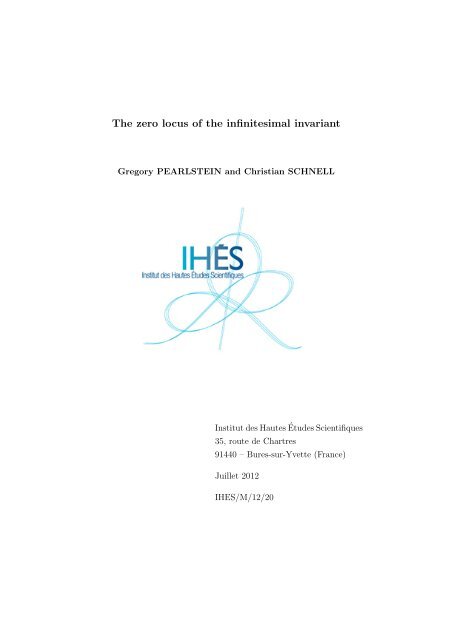
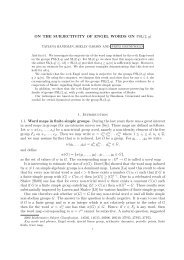
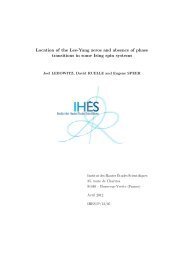


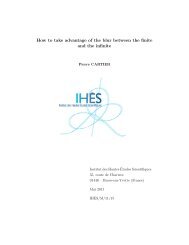

![arXiv:math/0512171v2 [math.RA] - Institut des Hautes Ãtudes ...](https://img.yumpu.com/29529619/1/190x245/arxivmath-0512171v2-mathra-institut-des-hautes-atudes-.jpg?quality=85)


